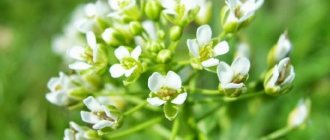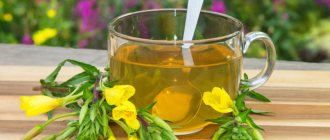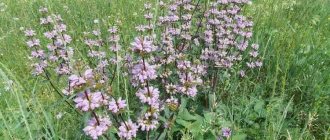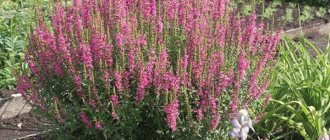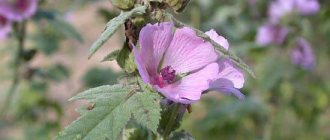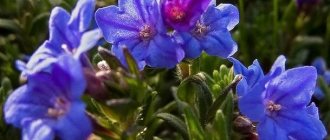What does iris look like and where does it grow?
The culture has several names:
- killer whale;
- flatbread;
- suitcase;
- piskulnik;
- singer;
- lionist
The perennial can reach a height of 90 cm. There are up to 10-14 flowers on flattened climbing stems. During evolutionary development, the external characteristics of the plant have changed. Gradually, the stem turned into a rhizome, which has a diameter of 3 cm.
Important! The growth of stems occurs to the side. The spread of iris is carried out thanks to creeping and branched rhizomes.
The xiphoid wide leaves are collected in rosettes. Their appearance resembles calamus plates. Iris is distinguished by a variety of colors of leaves and stems. Their shade can be either bluish or rich green.
The flowering phase occurs in mid-summer. The downward perianth has a pale yellow tint. The stamens are cream colored.
The lifespan of each flower is up to six days. In its place, the development of a fruit occurs, which resembles a triangular box. It is filled with large seeds. Fruit ripening is observed in the second half of August.
Iris reproduces both vegetatively and by seeds
The cockerel is valued for its ease of care. It grows quite quickly and has pronounced decorative qualities. The distribution area of the iris covers:
- Europe;
- Asia;
- South and North America;
- Africa (partially).
The cockerel prefers moist meadow soils with a maximum content of acidic substrates. The perennial is found in river valleys and on the banks of reservoirs.
Iris is represented by more than 200 species and varieties. They differ in their growing area. Among the most common types of cockerel are yellow, Siberian, bristly, dwarf, German, Dutch, swamp, and swordtail. They have significant differences in external characteristics.
How and when to replant irises
Irises can be planted in three ways - rhizomes, shoots and grown from seeds. Getting plants from seeds is the longest and most difficult way. In practice, it is much easier and faster to grow flowers by dividing the bush and cuttings. At the same time, plants grown from rhizomes will bloom the next year, and seed planting will have to wait another 2-3 years.
How and when to replant irises:
- the best time for replanting is early spring, that is, March-April, before flowering;
- Flowers are propagated by dividing rhizomes and sprouts.
Transplanting irises in the spring to another place is carried out using only healthy and strong plants that will quickly and easily take root. The rhizomes are removed from the ground and divided into parts so that each individual root rosette has one leaf bud. Excess foliage should be trimmed. Before planting, the roots are dipped in a solution of potassium permanganate for several minutes for disinfection. Dried rhizomes are planted in shallow trenches or small planting holes at a distance of 50-60 cm from each other.
When propagated vegetatively, the iris must bloom at least once. After this, until budding, young shoots can be taken from it. New plants should be rooted from March to May in a shaded place, creating greenhouse conditions. Complete rooting can be observed after 2-3 weeks.
Irises can be grown from seeds. In autumn, the seeds are sown in a pot with a sandy substrate, covering it with polyethylene or glass. By spring, the seeds will germinate, they are picked and planted in open ground. When to plant irises in open ground in spring? The optimal time for planting in the ground is early spring, the months of March and April. By this time, the young plantings will have grown enough and will be able to quickly and fully take root in the ground.
Composition of iris
The medicinal properties of iris are due to the presence of biologically active substances. The roots of the plant are rich in essential oils containing iron ketone. This component explains the presence of a specific pleasant aroma. Other constituent substances include:
- linalool;
- geraniol;
- methyl esters;
- aldehydes;
- furfural;
- phenol;
- acids, for example, oleic, benzoic, tridecyl.;
- starch;
- tannins and resins;
- iridine glycoside;
- amino acids.
Chemical composition of orris root
Beneficial substances are concentrated mainly in the rhizome of the iris plant.
It contains:
- aldehydes;
- starch;
- ascorbic acid (vitamin C) in noticeable quantities;
- a set of essential microelements;
- tannins;
- resins;
- essential oils;
- flavonoids;
- carotenoids;
- iridine glycoside;
- Sahara;
- various organic acids.
Did you know? If, according to popular belief, the iris in general symbolizes eloquence, then its white flowers are associated with innocence, blue
-
with fidelity, and violet
-
with wisdom.
What are the benefits of iris?
The use of cockerel-based products has a positive effect on the body. The raw materials contain the components necessary to maintain health.
What are the benefits of orris root?
This part of the plant is rich in phenolic substances and produces an antiseptic effect. The roots are necessary for the treatment of inflammatory processes in organs related to the respiratory and urinary systems, and the digestive tract. They are a source of flavonoids that strengthen the heart muscle and normalize blood pressure.
The use of products from the roots of the cockerel helps to normalize hormonal levels, which is especially important during menopause
Beneficial properties of iris essential oil
The product is widely used in cosmetology, folk medicine, and perfumery. Using an oil solution heals the scalp and face. Its use is accompanied by a regenerating effect.
Iris essential oil is suitable for the care of sensitive skin types.
Methods of preparation and use
In folk medicine, various versions of medicines based on cockerel are used. The forms are easy to prepare and versatile.
Tincture
To make the drug, take in equal parts:
- orris roots;
- vodka or alcohol 70%.
The tincture is made as follows:
- Fresh roots are thoroughly washed and ground in a meat grinder.
- The resulting slurry is mixed with an alcohol solution.
- The product is placed in the refrigerator for three weeks.
Iris tincture is intended for both external and internal use.
Infusion
An aqueous solution is a universal remedy. It is used for various pathologies. To prepare the infusion you need to take:
- orris root powder - 1 tsp;
- hot water - 2 tbsp.
The drug is made as follows:
- The dried root must be ground to a powder.
- The raw material must be filled with water and left for two hours.
- Before use, the composition must be strained.
Drink 100 ml infusion of orris roots four times a day.
Decoction
The product is made using the following components:
- 10 plant seeds;
- 1 tbsp. boiling water
The decoction is made as follows:
- The raw materials are poured with boiling water.
- The drug is simmered over low heat for five minutes.
- The liquid is infused for four hours.
- Before use, the product is filtered.
Iris decoction is consumed daily up to three times a day, ½ tbsp. after meals, mainly for the treatment of malignant tumors
Tea
The medicine includes:
- raw materials - 1 tsp;
- boiling water - 1 tbsp.
To prepare tea you need:
- Pour water over the crushed roots.
- Leave the composition for an hour.
We recommend reading: Tea with thyme: beneficial properties and contraindications
It is advisable to strain the drink before drinking. The finished product is drunk warm.
Iris tea is usually prescribed for mastopathy
Oil
The dosage form is often used in the field of cosmetology. The oil solution is included in masks for skin and hair care. The form is also intended for internal use.
Iris oil is prescribed for diseases of the digestive system
Powder
The remedy is made from dried roots. Iris raw materials are ground using a coffee grinder.
Cockerel powder is the basis for making infusions and decoctions
Orris root: beneficial and medicinal properties, contraindications
Iris includes 250 species that grow throughout Asia, Europe, North America and some areas of Africa. This perennial is a unique herbaceous plant with powerful corm-like rhizomes. They have two main types of shoots - generative and vegetative. Sword-shaped flat leaves with a waxy coating are collected at the base of beautiful peduncles in special fan-shaped bunches.
Many species have few or no stem leaves. Single flowers are located in few-flowered inflorescences. They are distinguished by their fragrant aroma and elegant shape. The rich range of different shades includes a wide palette from dazzling white to dark purple. The large flowers consist of six petal-like lobes of a typical perianth. The three outer lobes are always slightly lowered. The flower's ovary has a three-lobed shape, and the pistil is somewhat dissected into 3 lobes.
Irises usually bloom from May to mid-July. The life span of each inflorescence is approximately three days. A flower bud is formed on the rhizome in summer. The fruit of the plant is represented by a three-lobed capsule. There are up to 16 seeds in one gram. Irises prefer to settle in open spaces, choosing the banks of reservoirs, steppe zones and deserts.
Useful properties of iris
In modern medical practice, several varieties of irises are allowed for use, including decorative varieties of Florentine and Germanic. The rhizomes are considered the main medicinal raw material of the plant, since their main active ingredient is a unique essential oil. The active component of this oil is iron ketone. Rhizomes are collected after planting in the third year. They should be washed in water, cleaned of lateral roots and aerial parts, dried thoroughly and stored in closed jars.
The rhizomes contain a large amount of essential vitamin C, starch, special sugars and other useful substances. In aromatherapy, the exceptional orris root is highly valued as a mild sedative. The plant is often used as an excellent expectorant and mild laxative. A healing decoction of orris roots helps to resolve dense tumors, eliminate severe headaches, and also cures gastrointestinal colic, bronchitis, sore throat and even pneumonia.
In modern cosmetology, a decoction is indicated for the effective elimination of freckles, pimples, wrinkles, and dandruff. This product is used for severe hair loss. This is an excellent hair stimulant that simultaneously increases hair thickness and shine.
Large iris leaves contain a significant amount of ascorbic acid. In India, rhizomes have long been used as an astringent and diuretic. And in some European countries, crushed leaves are still consumed due to their diaphoretic properties.
It has been proven that in addition to essential oil, iris contains isoflavones, flavonoids, iridine glycoside, carotenoids, fatty oil, various organic acids and tannins. It has immunomodulatory, anti-inflammatory, antitumor, antibacterial, antimycotic, detoxifying, antioxidant, anthelmintic, hemostatic, astringent, antipyretic, diuretic, restorative, analgesic, tonic and obstetric effects.
Application of iris
In the form of miraculous infusions, the plant is used for toothache and dropsy. For scurvy, various iris rinses are prescribed. Rhizomes are part of the popular breast tea. Modern homeopathic remedies based on the presented plant are prescribed for the effective treatment of the salivary glands and inflammation of the pancreas.
To prepare the infusion, you will need a glass of boiling water for 15 grams of raw materials. This remedy can be taken orally up to 6 times a day, 1 tbsp. l. Dried orris roots are considered an excellent expectorant and blood purifier. In addition, it has a powerful diuretic effect. It is prescribed for papillomatosis of the bladder and serious anacid gastritis.
To prepare a decoction of iris, you need to take 1 tsp. powder of crushed rhizomes and pour 300 ml of boiling water over them. Boil the mixture over low heat, always covered, for at least 5 minutes. Then the product should be infused in a warm place for about two hours. After straining the resulting decoction, it is recommended to gargle and rinse the mouth for sore throats and stomatitis. To get rid of long-term non-healing wounds and trophic ulcers, you can wipe them with this wonderful remedy.
For coughs, pain in the gastrointestinal tract, colds, as well as for bladder cancer and polyps, it is recommended to take half a glass of the decoction orally warm. For neurodermatitis and diaper rash, it is recommended to sprinkle the affected areas of the skin with powder from iris rhizomes.
A healing tincture of iris is prepared within two weeks from a ratio of 1 part rhizomes, which are finely crushed, and 10 parts regular vodka. In case of circulatory problems, severe pain and constant cramps in the stomach, you can take 20 or 30 drops per day at least three times a day. The tincture should be diluted in a small amount of water. This remedy is also indicated for the treatment of chronic pulmonary diseases.
An alcohol-water extract from medicinal iris rhizomes actively inhibits the development of tuberculosis bacillus. The essential oil of the plant is used in perfumery and aromatherapy. The fantastic aroma of the oil gives a feeling of comfort and harmony, it improves mood and helps with nervous disorders. Various creams based on the presented iris oil can boast a powerful regenerating effect, while at the same time they make the skin soft and velvety.
The use of iris in folk medicine
The plant is actively used in folk medicine. Perennial-based drugs are suitable not only for external, but also internal use.
For wounds and ulcers
The aqueous solution is used in the form of lotions. To prepare it take:
- water - 250 ml;
- raw materials - 1 tsp.
The infusion is made like this:
- Dried iris rhizome is ground into powder.
- The raw materials are filled with water at room temperature.
- The product is left for nine hours in a dark place.
Lotions with iris infusion accelerate skin regeneration when its integrity is damaged
For hepatitis
The decoction has a beneficial effect on the liver. To prepare it take:
- water - 1 tbsp.;
- iris seeds - ¼ teaspoon.
To make a healing composition, they are guided by the following algorithm of actions:
- The seeds are ground into powder using a coffee grinder.
- The raw materials are poured with cold water.
- Bring the mixture to a boil and simmer over low heat for ten minutes.
- After an hour, the liquid is filtered.
Iris decoction is taken 30 minutes before meals, ½ cup three times a day.
To strengthen the immune system
The product has general strengthening properties. Composition includes:
- 1 stem of cockerel;
- 1 tbsp. water.
Preparing the decoction is simple:
- The dried stem is cut and ground into powder.
- The raw materials are filled with hot water.
- The mixture is boiled for four minutes.
- The composition is infused for an hour and then filtered.
Iris decoction is taken four times a day, half a glass.
Important! It is advisable to add 1 tsp of honey to the product.
For throat diseases
The drug has antibacterial properties. To prepare the tincture, take:
- 250 ml of pulp from fresh plant roots;
- 250 ml vodka.
The alcohol solution is made as follows:
- Fresh roots are washed and chopped.
- The gruel is mixed with vodka.
- The product is infused for three weeks in a cold place.
The throat is gargled with a solution containing 1 tbsp. chamomile infusion and 1 tsp. alcohol tincture of cockerel
Against cough
Iris multicolored has medicinal properties. Plant-based products can thin mucus and eliminate cough. To prepare the medicinal composition use:
- 2 tbsp. spoons of orris root powder;
- 1 liter of hot boiled water.
The infusion is made like this:
- The dry roots are first chopped and then ground into powder form.
- The raw materials are poured into a thermos and filled with water.
- The mixture is infused for eight hours.
Drink iris infusion for cough three times a day, ½ tbsp.
For constipation
According to the instructions for use, iris is classified as a plant with a laxative effect. To make a healing composition, take:
- 1 small young stem;
- 1 tsp. honey
The preparation is quite simple:
- The stem is finely chopped.
- The raw materials are mixed with honey.
The resulting iris pulp is consumed internally if you are prone to constipation.
With heavy menstruation
Significant blood loss during menstrual periods can trigger the development of anemia. To normalize the cycle, use a remedy that includes:
- 50 g iris powder;
- 1 tbsp. cold water.
Preparation of the drug includes the following steps:
- The rhizomes of the plant are crushed to obtain a powder.
- The raw materials are filled with water.
- The composition is simmered in a water bath for 15 minutes.
- The broth is filtered and the original volume is restored by adding boiled water.
The total amount of the drug is divided into three parts and taken in the morning, afternoon and evening to prevent anemia
IRIS root - folk healer
Iris belongs to the herbaceous plants of the Iris family. It is a perennial with a rhizomatous tillering type. It grows everywhere in areas with temperate or subtropical climates. The stems are most often branched. The leaves are usually long, solitary, and collected at the base of the stems. Flowers are located on the tips of the shoots
People have known about irises since ancient times. This unique plant owes its beautiful name to the ancient Greek goddess of the rainbow - Iris, who descended to the earth on her light rainbow wings. (Iris translated from Greek means “rainbow.”)
Irises are also popularly called iris and cockerels. In nature, there are hundreds of species of this herbaceous plant. Among irises you can find both very miniature and very tall large-flowered varieties.
Thanks to selective breeding, decorative flowers of the most varied shapes and colors have been bred. Therefore, irises often decorate flower beds in parks, alleys and summer cottages. The most common plants are those with purple, blue, yellow, white or mixed (rainbow) colors.
The first bright flowers of wild and garden forms appear in early spring or late April and continue to delight the eye almost until July. After rapid flowering, fruits with seeds are formed in place of the inflorescences. There are at least 10 seeds in one three-nest box.
Beneficial features
Irises are not only charming flowers. Due to their unique chemical composition, they are widely used in medical practice. For medicinal purposes, the root of the plant is most often used.
Pale iris, Florentine, and Germanic are plant varieties whose rhizomes are most used in folk medicine. It is usually harvested in the fall. The peeled root, dug out of the ground, is cut in half and dried in the attic, in a place protected from sunlight.
The finished medicinal raw material is called iris, iris or “orris root”. It can also be bought at a pharmacy.
The roots are rich in essential oil, which in turn contains a significant amount of iron (fragrant substance). It also contains healthy organic acids, vitamin C, iridine glucoside, flavonoids, isoflavonoids, tannins, fatty oil and starch.
Indications for use
Orris root is valued in folk medicine and homeopathy as an effective sedative, expectorant, antitumor, analgesic and mild laxative.
In addition, it has antibacterial, antifungal and antidote effects.
The decoction treats sore throat, chronic bronchitis, pneumonia, relieves fever, colic in the abdomen and stomach.
The peoples of India use the rhizome of the plant as a diuretic (diuretic) and anti-inflammatory agent.
The powdered leaves are consumed in extreme heat. This herbal powder is used to reduce hyperemia and inflammation of the mucous membrane or wound, improve skin regeneration, and as an astringent and enveloping agent.
Preparations based on orris root are used to relieve pain during childbirth and to expel helminths from the body.
The essential oil of this wonderful plant is widely used in perfumery and cosmetology. Iris decoction gets rid of age spots and freckles. This product is effectively used for hair loss and to eliminate skin rashes. The root extract gives stunning results in the fight against wrinkles and dry skin.
Dried raw materials crushed into powder are added to culinary, bakery and confectionery products as a flavoring agent.
In southern countries, jam is made from white iris petals. In addition to the original taste, it has excellent healing properties: it increases vitality, normalizes metabolic processes, saturates the body with glucose, vitamins and microelements.
Iris infusions in the treatment of ailments
Infusions. They are prepared from the rhizome and used internally for various ailments, namely: bronchitis, pneumonia, severe cough, dropsy, kidney and bladder diseases, constipation, poisoning, stomach pain. Externally, the water infusion is used to rinse an inflamed throat and mouth with sore throat, tonsillitis, glossitis and stomatitis. The root is crushed and brewed in a thermos. For 2 spoons of raw materials, take 300 milliliters (a cup) of hot boiling water. Infuse the composition in a thermos. Strain after 6 hours. For severe bronchitis, cough and fever, drink an infusion of 90-100 milliliters at least three times a day.
For dropsy, kidney disease and edema, drink the remedy prepared above according to the following dosage: 1 tablespoon three to four times a day. For myxedema, the medication intake can be increased.
For skin diseases, wounds, tumors and hardening, wipes soaked in a warm infusion should be applied to the sore spot. The procedures are carried out within 25-30 minutes.
If you have nervous exhaustion, you should drink this infusion. Add one teaspoon of crushed roots to 400 ml of hot boiling water. Infuse the product and take 100-150 ml three to four times a day.
Treatment with decoctions
A decoction of orris root is taken to treat inflammatory processes in the body, pneumonia, bronchitis, tuberculosis and cough. It is used to gargle a sore throat, teeth and gums. Lotions with a decoction effectively treat burns, purulent wounds, ulcers and mastitis. Sitz baths are used with it for hemorrhoids with nodular cones.
Add one tablespoon of root to 200 milliliters of water. Boil the mixture over low heat for no more than 8 minutes. Take the prepared product, strained through gauze, orally, 1 spoon three times a day before meals. The course of treatment for inflammatory and infectious diseases is at least one week. The decoction is used to wash the hair for baldness, hair loss and dandruff.
Alcohol tincture
This dosage form of iris is taken orally for many diseases: colitis, intestinal spasms, constipation, infections, tuberculosis, mycosis. In addition, the tincture is also used externally to treat wounds, heel spurs, mastitis, mastopathy and skin rashes.
Prepare the tincture as follows. The root, freshly dug in the fall, is crushed (preferably in a blender) and poured 1:1 with alcohol (50-60%). (For this, you can use proven homemade moonshine.) Place the product in a place protected from light for 15 days. Moisten gauze with the finished tincture and apply it to the sore spot. For heel spurs, keep this compress all night. The procedure is carried out every other day.
For diseases of the throat, tongue and gums, rinse as follows: take 35 drops of tincture per 180 ml of warm boiled water. The drug is used for respiratory tract infections and tuberculosis. Instead of water in this case, take a decoction of birch leaves, nettles, chamomile flowers, yarrow herb, creeping thyme, mantle or wild rosemary.
Iris with honey
This remedy is used for constipation and colitis. The stem or fresh root of the plant is ground in a meat grinder and mixed with honey. Take a tablespoon in the morning and, if necessary, in the evening.
Contraindications for the use of “orris root”
Before starting treatment with orris root medicinal forms, you should consult your doctor. Some biologically active substances contained in the plant may cause adverse reactions or individual intolerance.
Source: Internet.
IRIS root hydrolate can be purchased in our store:
Application in cosmetology
It is noteworthy that the first creams containing cockerel root appeared approximately 3000 years ago. Powder from the raw material was added to ointments and lipsticks during the Middle Ages. Many years ago, the property of orris root to preserve the freshness of cosmetics was known.
Betta-based products have a positive effect on skin conditions, which are manifested by:
- eliminating acne;
- tightening the oval of the face.
The extract of the medicinal plant is used in anti-aging cosmetics due to its moisturizing and nourishing effects. Serums and toners designed for teenage skin are effective due to their ability to inhibit the growth of pathogenic organisms that cause rashes and acne.
Collection and preparation
The culture is actively used in folk medicine. The collection of raw materials is carried out according to certain rules. In particular, harvesting is not carried out in the first year of a cockerel’s life. Collection must be done in August or September. The rhizome is carefully dug up and washed. The fruits are cut lengthwise and dried in the sun.
Raw materials are stored in a dry, dark and cool place. Plant parts are placed in stack dishes or paper bags. You can use the harvested raw materials within two years.
Magical properties of iris
The plant is distinguished not only by its spectacular appearance. The cockerel is known for having medicinal properties. Since ancient times, iris has been used by sorcerers.
The special smell of the plant and the iron content made it possible to use the cockerel to prepare products used to spray the chambers of kings. Culture was considered a symbol of perfection. Boys were bathed in perennial decoctions to strengthen their fortitude. It was believed that the plant could impart courage, wisdom and fearlessness. Iris is associated with youth. The cockerel brings harmony and develops eloquence.
The appearance of the perennial is explained by legends. According to one of them, the flowers emerged from a rainbow that had crumbled into fragments. A sea legend says that the plant sprouted from the tears of a fisherman who mourned the separation from her lover in the meadows.




